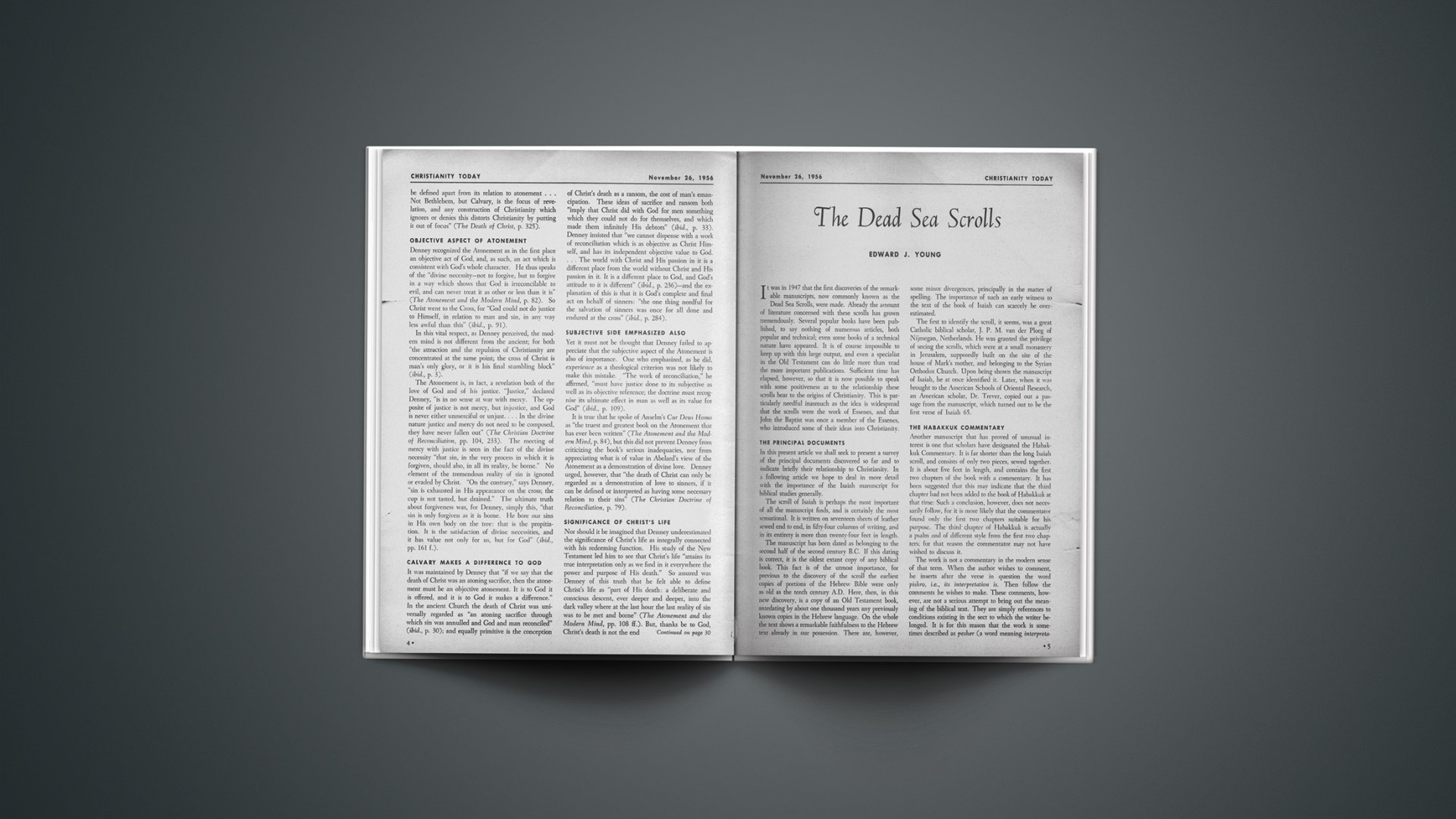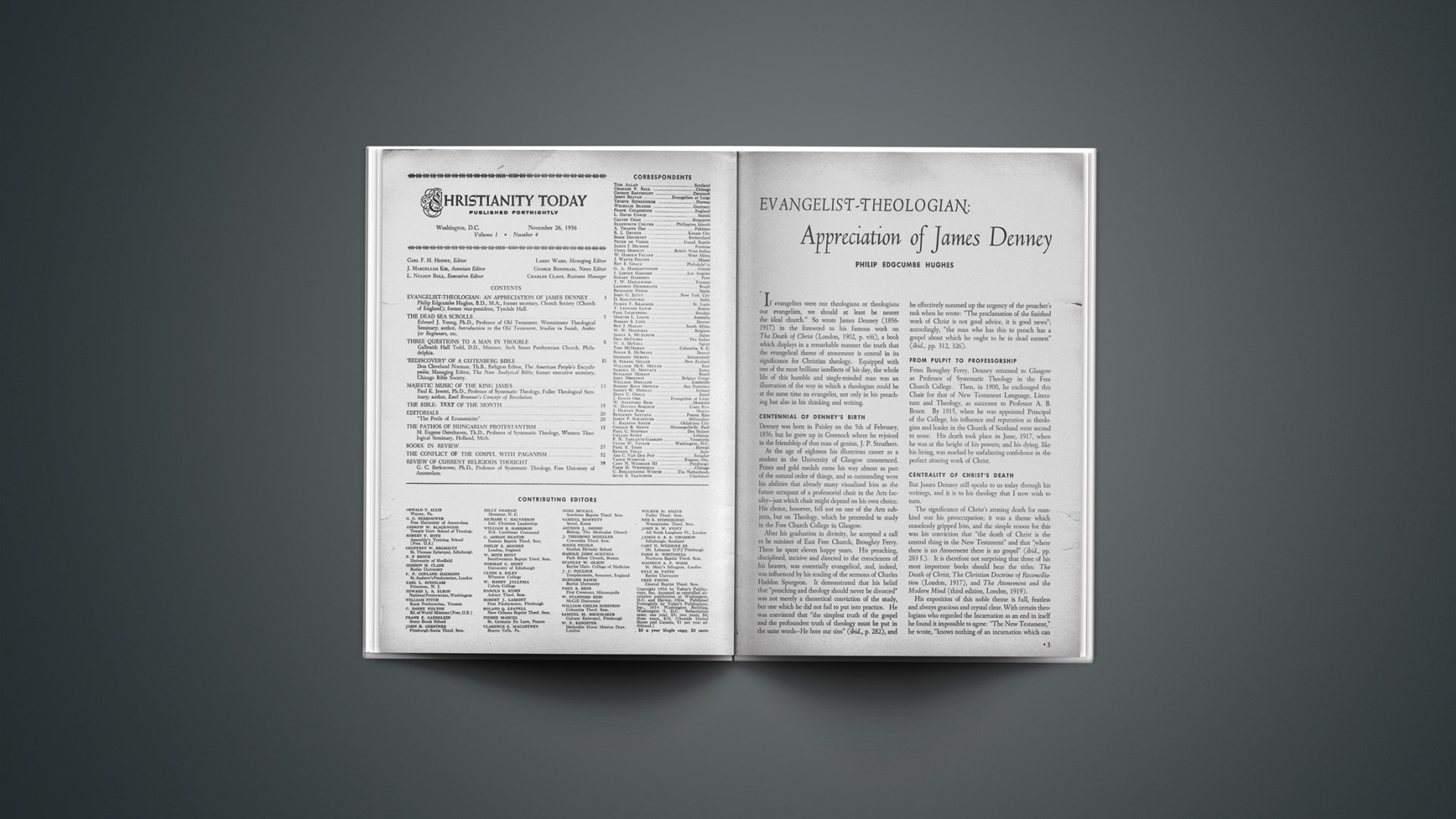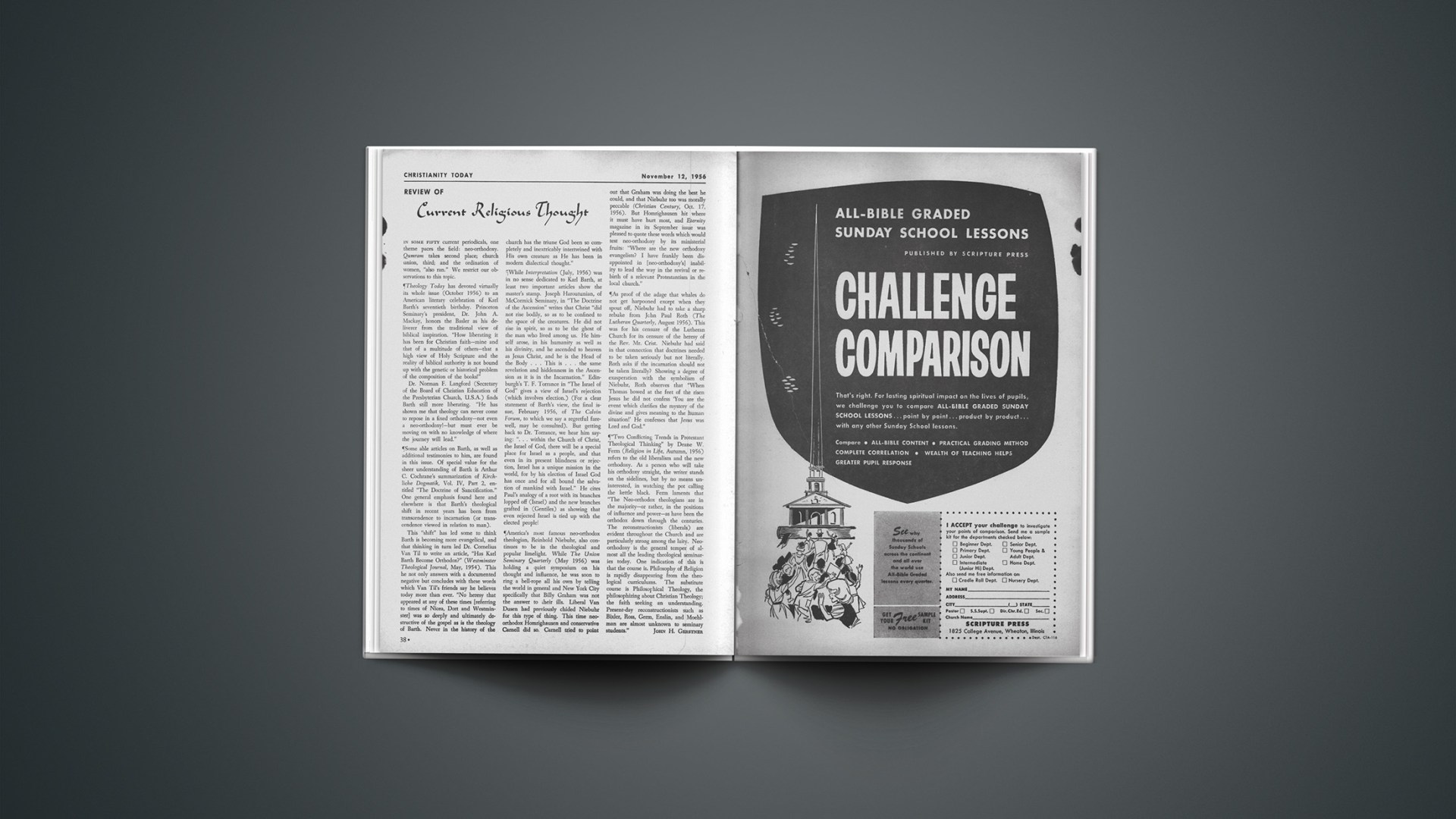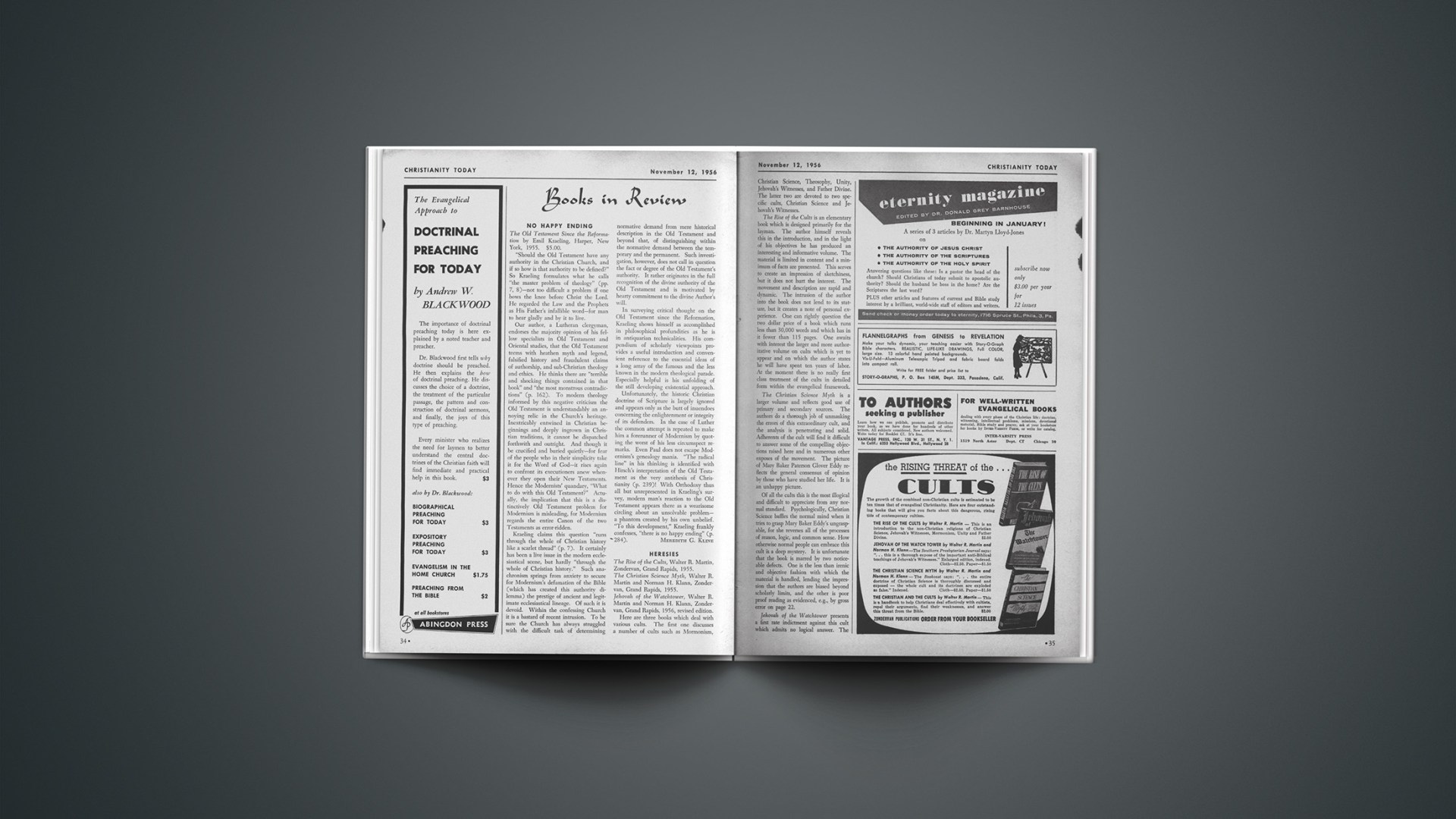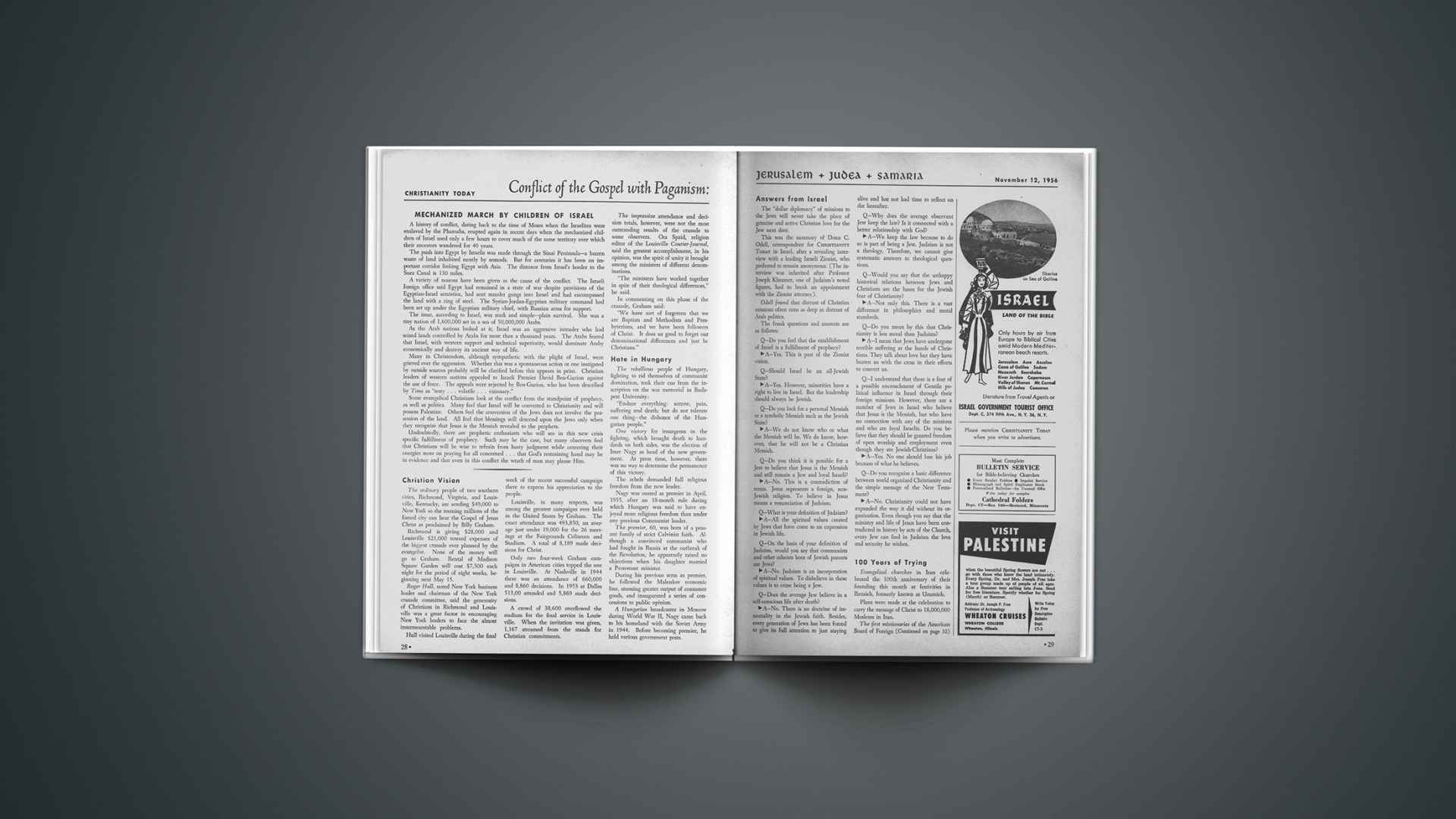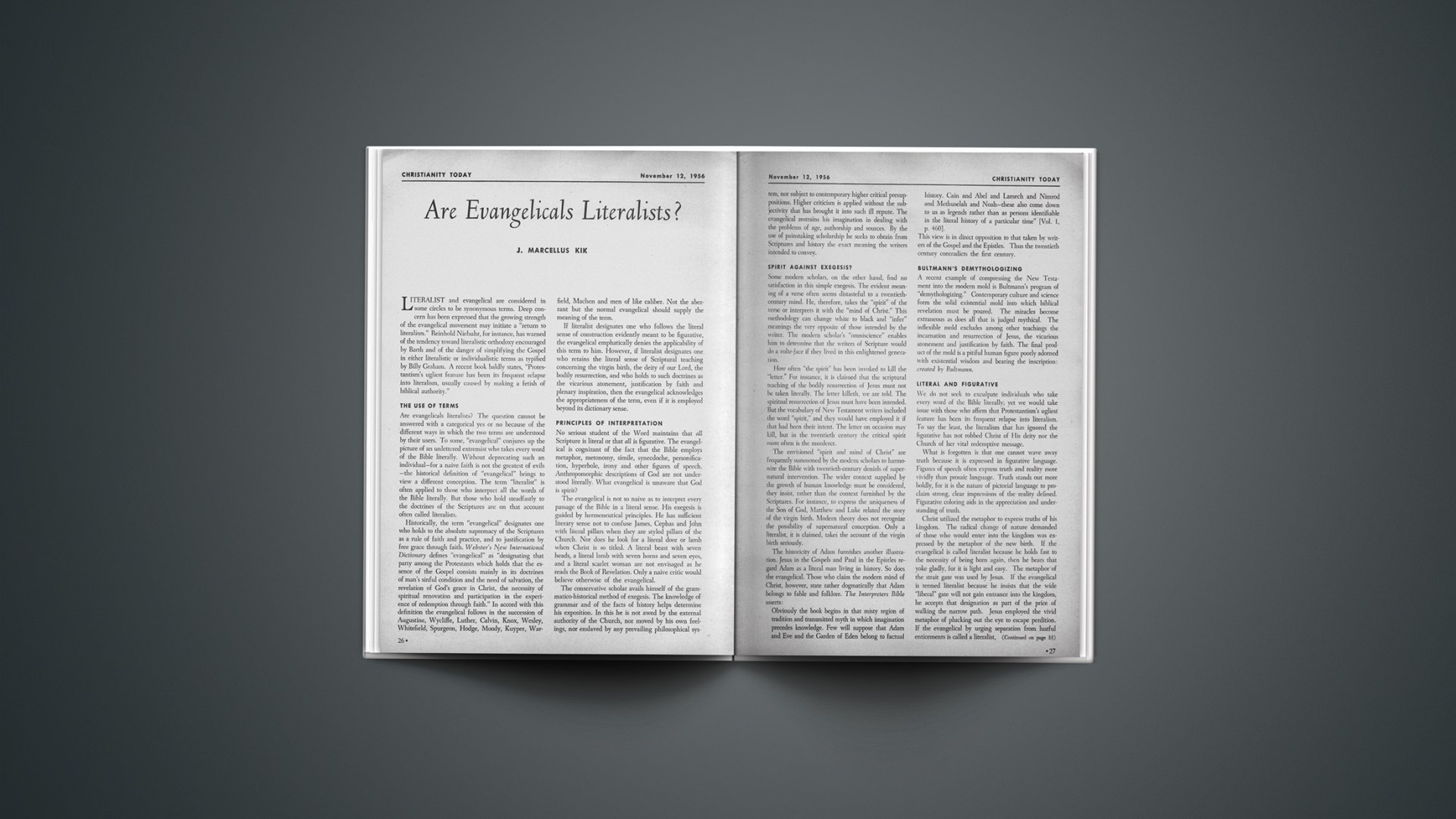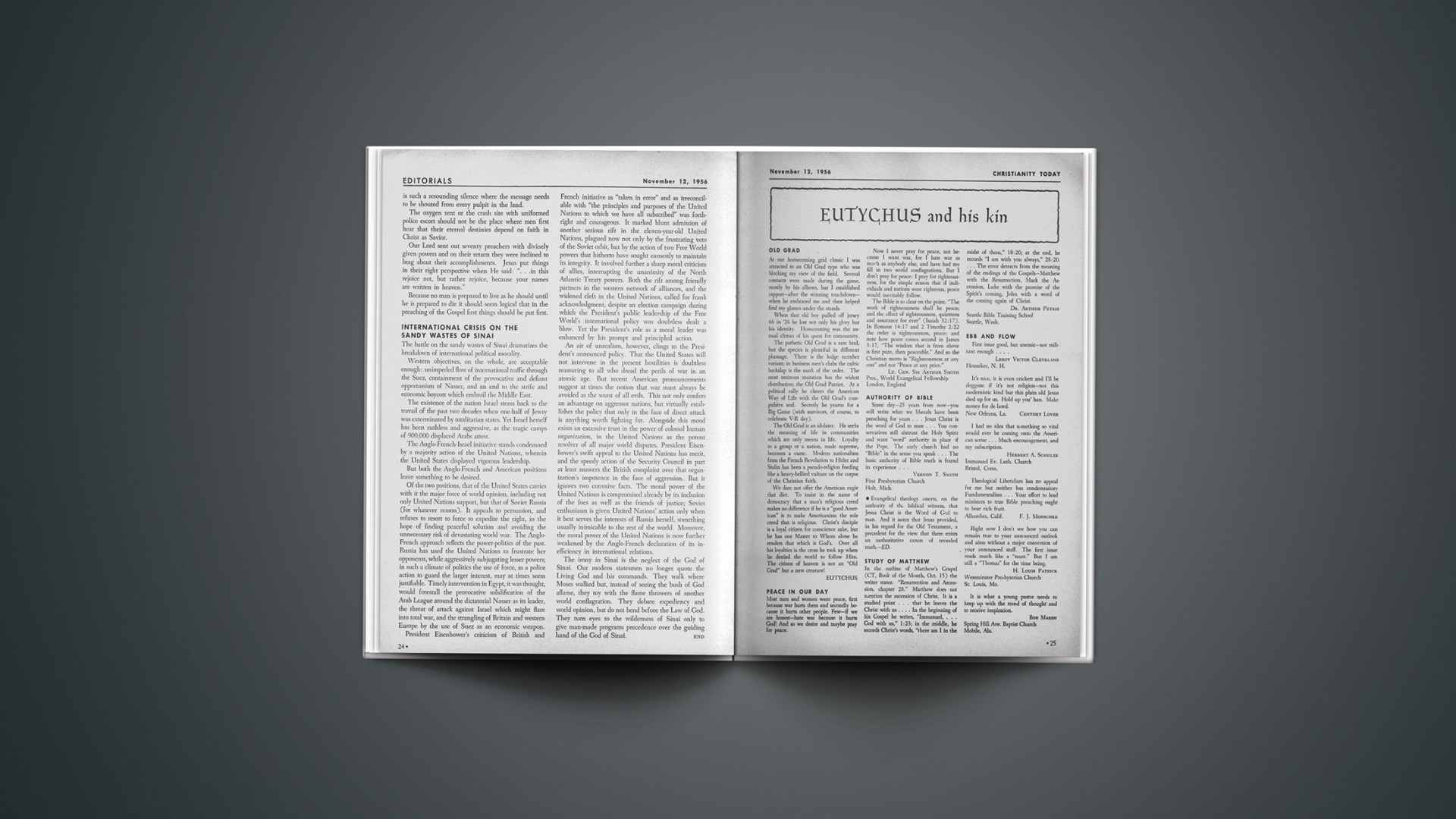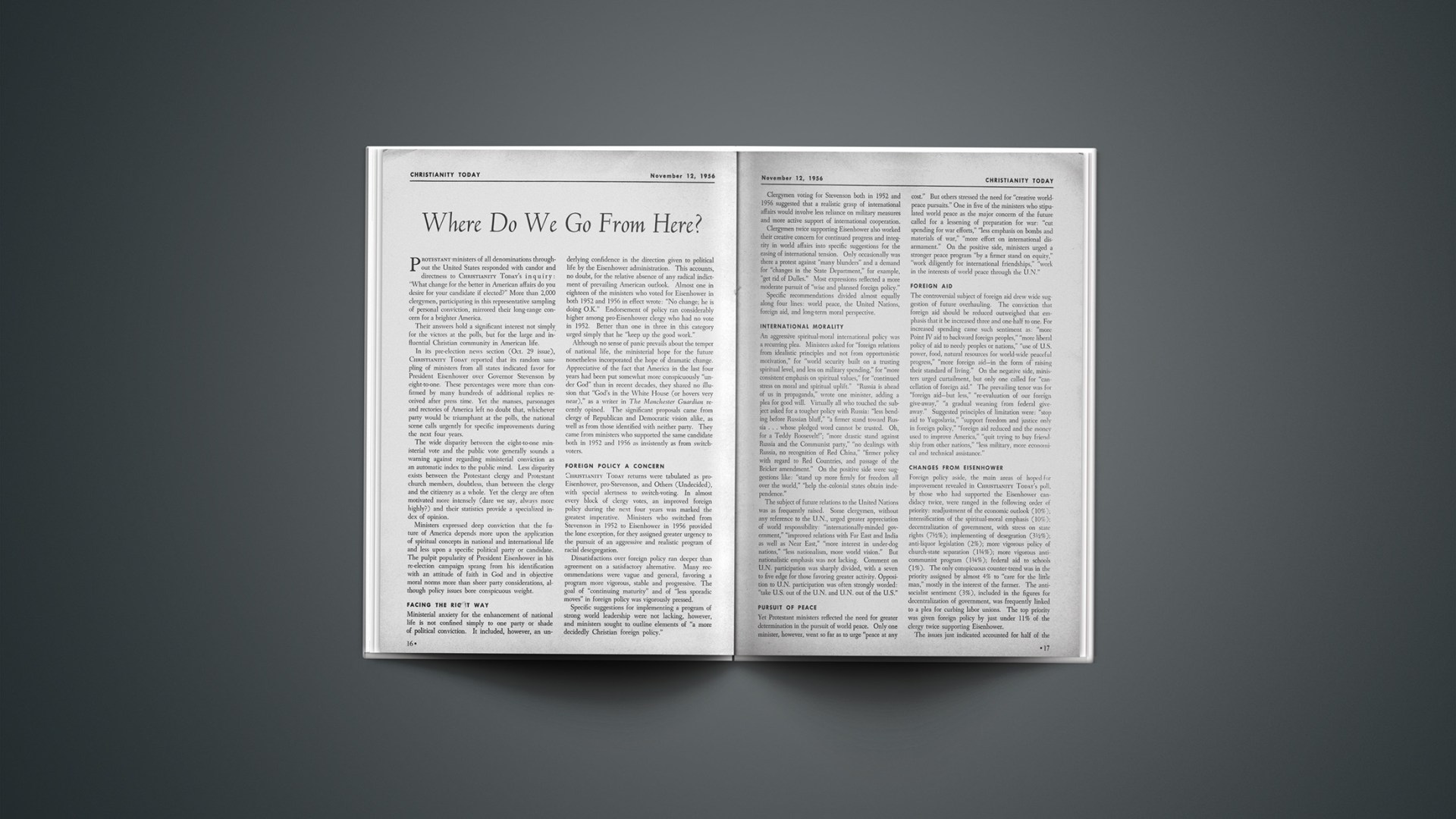Text: Job 38:4; 40:12b; 40:15; 41:1
In a world where most persons are filled with a strong passion for publicity and recognition, it is difficult to conceive of an author giving to the world what is unquestionably one of its greatest books and then scorning to blot it with a name.
We do not know the identity of the author of the Book of Job any more than we know who wrote the great Anglo-Saxon epic, Beowulf, or the Latin hymn of the nativity, “Adeste Fideles.”
We do know that the writings of a Homer, a Dante, a Shakespeare, a Milton, a Goethe cannot approximate the Book of Job. We have long since reached the conclusion of James Anthony Froude, who said that the Book of Job towers up alone, far above all the poetry in the world. We agree quickly with Thomas Carlyle when, in his Heroes and Hero Worship, he describes the Book of Job as “a noble book, grand in its sincerity, in its simplicity, in its epic melody … and its sublime sorrow, sublime reconciliation, the oldest choral melody as of the heart of mankind—so soft and great, as the summer midnight, as the world with its stones and seas.” “There is nothing written,” Carlyle goes on to say, “in the Bible or out of it of equal literary merit.”
The scope of the Book of Job is sometimes lost to us in the loquacity of Job’s would-be comforters. Let us refresh our memories by going over the broad outline of the book.
Job was a God-fearing, clean-living, upright man. He was exceptionally prosperous and in his prosperity he did not forget his religion and his God. He was a man of prayer. He was a man of kindness. The law of kindness was on his lips. Like Barnabas, in the Acts of Apostles, he was a “son of consolation,” whose vigorous, tactful, well-chosen speech gave encouragement and stability to other lives. He was a family man and gave large thought to the spiritual welfare of his children. It was for them that he constantly interceded before God.
Upon this irreproachable man troubles descended in ever-increasing measure. Job was the victim of thugs. Bandits swooped down out of the hills, slaying all of his servants except one sole survivor who brought him the shocking news. Again, Job was the victim of the mercilessness of nature. Lightning struck his shepherds and his sheep in the field. Yet again, a second band of robbers out of Chaldea raided one of his farms and stole his cattle.
Tragedy was not done with him yet. He fell victim to nature’s cruelty once again. The younger generation of his household were holding a family party. The eldest son played host to them in his home. A cyclone struck the house and, when the night of terror and storm was over, the bodies of Job’s seven sons and three daughters were discovered in the debris. The plight of Job’s family reminds us of that tragedy in the spring of 1953 when an entire family reunion group was wiped out in a cyclonic storm in Nebraska.
The victim of criminals and of untamed forces of nature, Job fell the prey of a vile and disgusting disease. His sickness was as humiliating as it was excruciating. His own wife proved to be of no help to his faith. So Job retired to the city dump—a miserable, pathetic spectacle. He resembled a cat or a dog, crawling out to some spot away from public haunt and finding there a suitable shelter in which to expire. As George MacDonald wrote, “Must it not be a deep spiritual instinct that drives trouble into solitude? Away from the herd flies the wounded deer; away from the flock staggers the sickly sheep to the solitary hiding place to die.” Three friends of Job came to his refuge at the city dumping ground. At the outset they maintained a respectful silence. One of the strongest supports in a time of profound sorrow may be the presence of friends who have the grace and good sense to come and be silent. At length Job was moved to speak out against his desperate plight. His bitter questionings may be summed up in a single word: Why? Like many others, he asked, “Why should this affliction befall me?”
The modern world is filled with persons suffering multiplied distresses. During his radio preaching, the late S. Parkes Cadman received this melancholy communication: “I am a man seventy-four years of age and I find myself utterly unable to explain the following situations. In 1895 my wife, sick with melancholia, took her own life. In 1901 my eldest son died of a fever. In 1920 my eldest daughter committed suicide during a period of mental depression. In 1921 my only remaining son and his two children burned to death in their own home. My questions about life can be summed up in one word, Why?”
In the face of a situation like that, what word is there from the Lord?
When Job reached the end of his questionings, God spoke. He asked three questions of Job. These three questions are found in the latter chapters of the Book of Job. They are questions equally applicable to the man in trouble today.
The Question Of Nature
The first question God asked Job was, What do you really know about the mysteries of nature? What do you really understand about the mysteries of science? “Where wast thou when I laid the foundations of the earth?” Where were you in creation’s morning? What do you know about the mystery of life and nature, about its origin and preservation? Where were you “when the morning stars sang together, and all the sons of God shouted for joy?”
God directed Job to the wonders of creation, so little of which man can fathom. What do you know about the mystery of the sea? Long ago Lord Byron wrote, “Man marks the earth with ruin. His control starts with the shore.” In a very recent and popular book, The Sea Around Us, Rachel Carson reaches the conclusion that, with all of our modern scientific instruments, the mysteries of the sea will never be solved.
What do you know about the mysteries of light? We would paraphrase the question, What do you know about the mystery of electricity? Thomas A. Edison, who explored the realms of light more than any other in our age, said, “No one knows one seven-billionth of one per cent about anything.”
What do you know about the mystery of rain? “Hath the rain a father? or who hath begotten the drops of dew?” What do you know about the mystery of snow?” “Hast thou entered into the treasures of the snow? or hast thou seen the treasures of the hail?” While under the shadow of a crushing bereavement, James Russell Lowell exquisitely interpreted Job’s question:
I stood and watched by the window
The noiseless work of the sky
And the sudden flurries of snowbirds,
Like brown leaves whirling by.I thought of a mound in sweet Auburn
Where a little headstone stood;
How the flakes were folding it gently
As did robins the babes in the wood.Up spoke our own little Mabel,
Saying, “Father, who makes it snow?”
And I told of the good All-father
Who cares for us here below.Again I looked at the snowfall,
And thought of the leaden sky
That arched o’er our first great sorrow,
When the mound was heaped so high.And again to the child I whispered,
“The snow that husheth all,
Darling, the merciful Father
Alone can make it fall.”
[Reprinted by permission of Houghton-Mifflin Company.]
What do you know concerning the mystery of the stars? “Canst thou bind the sweet influences of the Pleiades, or loose the bands of Orion? Canst thou bring forth Mazzaroth in his season? or canst thou guide Arcturus with his sons?”
What do you know about the strange instincts of the animal kingdom, the little wild things that share with us the mystery of life, the beasts of the field whose ways are still past our finding out?
The most distinguished scientists have had to stand awed and baffled before the opaque depths of life. They have to exclaim with Job, “We are but of yesterday, and know nothing.” Or with Paul, “Now we see in a mirror darkly, we know in fragments.” Or with Socrates, “One thing I know, that I know nothing.” Or with Emerson in his teasing epigram, “Knowledge is knowing that we cannot know.” Or with Herbert Spencer, who declared that in its ultimate nature, life is incomprehensible. Or with Ernest Haeckel, who, though he was possessed of a certain arrogance in his claims which would cause one to suppose that for him the mysteries of science were a diminished domain, made the confession, “We grant at once that the innermost character of nature is just as little understood by us as it was by Anaximander and Empedocles twenty-four hundred years ago, by Spinoza and Newton two hundred years ago, by Kant and Goethe one hundred years ago. We must even grant that this essence and substance become more mysterious and enigmatic the deeper we penetrate into the knowledge of its attributes.” Honest science is brought back repeatedly to the confession that the world grows more mysterious the more we know about it.
In the mysterious realm of nature we have to trust to the wisdom and greatness, the goodness and integrity of God. Like the marsh hen in Lanier’s poem, secretly building her nest and ordering her uncertain flight on the greatness of God, we have to repose our confidence in the God to whom the darkness of nature is as light. If we trust him in the mysteries of nature, shall we not trust him as completely in his mysterious, providential dealings with us?
The Question Of Evil
The second question which God addressed to Job in his trouble, and which he addresses to us is, What do you really know about the mystery of evil? “Cast abroad the rage of thy wrath: and behold every one that is proud, and abase him. Look on every one that is proud and bring him low; and tread down the wicked in their place.” Can you “tread down the wicked in their place?” What do you really know about evil when it is treated as a theological problem? What do we know about its origin, its continuance in a world governed by God, the manner in which it is overruled and even used for his glory?
What do you know about evil as a social problem? Do you really comprehend the motives for the crime and violence now menacing the nation, “the black fringe around our society,” as the late Joseph Fort Newton once called it?
Not long since I visited the beautiful campus of Williams College at Williamstown, Massachusetts, with its venerable memories of Dr. Mark Hopkins, the physician turned preacher and philosopher, of President Garfield and John Bascom, and of William Cullen Bryant, who as a seventeen-year-old college student there wrote his immortal “Thanatopsis.” It was there, too, that the Haystack Prayer Meeting was held, which was the fountainhead of the American foreign missionary movement. That very summer day as I stood under the elms of Williamstown, the newspapers printed the story of two brothers from that historic and cultured community, aged twenty-three and eighteen, who that week had embarked on a series of criminal exploits that led them eventually into the mountains of Pennsylvania. In the presence of so much that is noble and exalting and good, how can young men launch out on careers of crime? More perplexing than the episode of those boys from the hills of western Massachusetts is the sinister course followed by some who have enjoyed the advantages of a devout and godly parentage in the formative years of life. One thinks of the renegade sons of the priest Eli, and of the sons of the prophet, Samuel, who brought disgrace upon their fathers. It is always baffling to see children, who have been born and bred in Christian homes and have been environed by the purest Christian influences, degenerating in lives grown sordid and stained and sodden.
We know little of evil as a psychological problem. Long ago the inspired Psalmist anticipated the modern depth psychologist who probes the recesses of the subconscious in order to explain human behavior. The Psalmist asked the question, “Who can understand his [own] errors? cleanse thou me from secret faults.” Jeremiah expressed the same thought, “The heart is deceitful above all things, and desperately wicked: who can know it?”
We know but fragments concerning evil as a theological, social and psychological problem. God’s provision for the forgiveness of our sins is no less beyond our poor powers to understand. We are “lost in wonder, love, and praise” as we contemplate the plan of salvation from sin. Through his atoning sacrifice of himself, in his death on the cross, Christ satisfied the divine justice, procured our pardon before the holy God, and was made sin for us (although he knew no sin) that we might be made the righteousness of God in him.
God’s power to change human life is as mysterious to us as his plan of salvation. His only begotten Son’s blood can make the foulest clean—as white as snow—releasing men and women from the thralldom of evil, lifting them out of the horrible pit, out of the miry clay, setting their feet upon a rock, transfiguring the worst of characters into the best.
We trust the mystery of evil, its existence and control, its redemption and conquest to God. Should we not also trust him in the quite inscrutable dispensations of his providence?
The Question Of Death
The third question which God addressed to Job in his perplexity and which he puts to us is, What do you know about the mystery of death? What do you know about that undiscovered country which lies beyond the last door of life?
God said to Job, “Behold now behemoth,” and again, “Canst thou draw out leviathan with an hook?” Behemoth indicates the hippopotamus and leviathan the crocodile. In 1850 Thomas Babington Macaulay wrote in an essay, “I have seen the hippopotamus both asleep and awake and I can assure you that awake or asleep he is the ugliest of the creatures of God.” In the mythological imagery of Egypt and the ancient East, the hippopotamus and the crocodile always represented death and the realms of the dead. In the symbolism of the Coptic church of Egypt in the early centuries, Christ is depicted standing upon a crocodile. Our Lord is thus shown in the splendor and power of his resurrection triumph over sin and the grave.
We know little of that soft, fascinating sleep men call death. We know little of that strange country of the beyond. It is sufficient for us to know that Christ demonstrated by his resurrection that he has the keys of death and the realm of the dead. It is sufficiently reassuring for us to know that as Richard Baxter, the Puritan divine, has said, “Christ leads us through no darker rooms than he has been before.” It is adequate comfort for us to possess the confidence that when we lie down to sleep for the last time, or when we watch our loved ones put out to sea, Christ stands at the gateway of immortality as our Savior and friend.
My knowledge of that life is small
The eye of faith is dim,
But it’s enough that Christ knows all,
And I shall be with him.
We trust our heavenly Father in the mystery of nature, in the mystery of evil and in the mystery of death. Should we not trust him through all the changing scenes of life?
At length Job in his experience passed beyond a mere intellectual concept of God to a knowledge of him as Father and* friend. “I have heard of thee by the hearing of the ear: but now mine eye seeth thee.” Job had found the God of his life, to whom he could say, Thou art mv God! Thou art the God who loves and cares for me and all whom I love here and beyond the bounds of vision.
We who know God in Christ trust him as the creator of the ends of the earth, the one in whom all things cohere, the redeemer who by his cross and precious blood answers the problem, sounds the doom and interprets the uses of evil. He is the Lord of life and death who “abolished death and brought life and immortality to light through the gospel.”
In a time when the faith of many was shaken and beclouded, Washington Gladden wrote these serene lines which voice the ultimate faith of Job and of all those whose hope and trust is stayed on the Lord Christ, and on the Father who sent him into the world and is with us as he was with him:
In the bitter waves of woe,
Beaten and tossed about
By the sullen winds that blow
From the desolate shores of doubt,
When the anchors that faith had cast
Are dragging in the gale,
I am quietly holding fast
To the things that cannot fail.In the darkest night of the year
When the stars have all gone out,
I know that courage is better than fear,
That faith is better than doubt.
And that somewhere beyond the stars
Is a love that is better than fate,
When the night unlocks her bars
I shall see him and I will wait.
Galbraith Hall Todd, D.D., is minister at Arch Street Presbyterian Church in Philadelphia.



